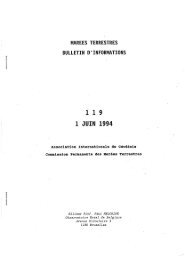marees terrestres bulletin d'informations - Université de la Polynésie ...
marees terrestres bulletin d'informations - Université de la Polynésie ...
marees terrestres bulletin d'informations - Université de la Polynésie ...
Create successful ePaper yourself
Turn your PDF publications into a flip-book with our unique Google optimized e-Paper software.
5. Noise in normal mo<strong>de</strong> band<br />
The Pecný station is located in a quiet p<strong>la</strong>ce, far away from industrial noise and the SG pil<strong>la</strong>r<br />
is foun<strong>de</strong>d on the quartzite bedrock. It should be expected, that noise in normal mo<strong>de</strong> band<br />
(0.2 mHz – 10 mHz) will be low and thus the conditions for monitoring Earth’s free oscil<strong>la</strong>tions<br />
excellent. Unfortunately, the comparison of power spectral <strong>de</strong>nsities with New Low Noise Mo<strong>de</strong>l<br />
(NLNM, Peterson 1993) in Fig. 6 shows sizeable noise in this frequency band. The seismic noise<br />
magnitu<strong>de</strong>(SNM, Banka and Crossley, 1999) of the OSG-050 is of about 1.4. To achieve best noise<br />
characteristic of the OSG-050, the influence of the <strong>de</strong>war pressure setting has been experimentally<br />
studied by comparison of power spectrums un<strong>de</strong>r different pressure condition. Improvement less<br />
than 5 dB has been achieved by sensitive setting of the <strong>de</strong>war pressure (see, Fig. 6).<br />
Fig. 6. Power spectral <strong>de</strong>nsities of the OSG-050 in normal mo<strong>de</strong> band for different <strong>de</strong>war pressures<br />
6. Conclusions<br />
During the first year of observation with the OSG-050 at Pecný the main parameters and<br />
characteristics of the meter has been <strong>de</strong>termined. Calibration coefficient and the time <strong>de</strong><strong>la</strong>y were<br />
estimated with the accuracy of 0.06% and 0.01 sec, respectively. The comparison of SG and AG<br />
observations helped to <strong>de</strong>termine the SG linear drift of 1.7 0.4 Gal/year and the FG5#215<br />
repeatability of 0.6 Gal. The analysis of recor<strong>de</strong>d data showed the very good properties of the<br />
meter for monitoring gravity variations below 0.1 mHz (earth ti<strong>de</strong>s, hydrological effects etc.). On<br />
the other hand the observations in normal mo<strong>de</strong> band (0.2 mHz – 10 mHz) are affected by sizeable<br />
noise of instrumental origin.<br />
The superconducting gravimeter OSG-050 at the station Pecný represents dignified<br />
continuation of earth ti<strong>de</strong> observation started in early seventies of the <strong>la</strong>st century. Thanks to the<br />
good drift characteristics of the meter and regu<strong>la</strong>r repeated absolute gravity measurements, there is<br />
a good chance to <strong>de</strong>termine valuable parameters of long-period ti<strong>de</strong>s and to monitor gravity<br />
variations of hydrologic and geodynamic origin. Moreover, the OSG-050 seems to be very<br />
important instrument for absolute gravimeter FG5#215 (national standard for acceleration due to<br />
gravity) to monitor variations of its systematic errors and consequently improve accuracy and<br />
credibility of our absolute measurements.<br />
11823



